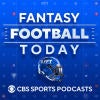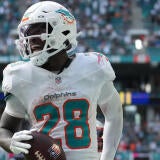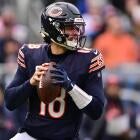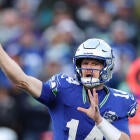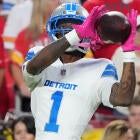Stealing Signals: AFC West 2019 recap, what to expect heading toward 2020
Ben Gretch reviews the 2019 season for each team from the AFC West.
With the 2019 regular season in the books, I'll be going division by division to share my initial offseason takeaways from each team.
This is mostly postseason note-taking as I emphasize what stands out most from the Stealing Signals column in 2019. We have an entire offseason of coaching and personnel changes plus additional research to break down what our 2020 Fantasy expectations will be, but I intend to refer back to these pieces as a barometer of sorts.
Denver Broncos
Snap Notes: Phillip Lindsay — 50% weekly average; Royce Freeman — 50% weekly average; Noah Fant — 68% weekly average (snaps ticked up through November, tailed off in December after multiple injuries)
Key Stat: Courtland Sutton — 36% share of team's receiving yards (second most in NFL to Michael Thomas)
It was a banner year for legit No. 1 wide receivers being held back by their passing offenses, and Courtland Sutton might be the clearest example. Sutton's rookie season catch rate was subpar in 2018 as he was never on the same page as Case Keenum — Sports Info Solutions graded 23 of his 84 targets that year as uncatchable — but he still posted a strong yardage total as primarily a deep threat.
In 2019, he hauled in more deep targets, but he also added intermediate looks as his aDOT fell from 14.0 to 11.9. That role change from a deep threat to a more well-rounded No. 1 added 40 targets and, with an associated increase in catch rate, 30 catches.
And yet, while working with three different quarterbacks, Sutton's rate of uncatchable targets actually rose. He accounted for a higher percentage of his team's passing yards than any player in the league not named Michael Thomas, and the scary thing is there is still pretty clearly room for his statistics to improve. From what we've seen, though, he's two years into what has all the makings of becoming a great career.
Emmanuel Sanders was the other featured piece in the passing game until his trade just before Week 8, and from that point on DaeSean Hamilton and Tim Patrick became the main additional receivers. Neither did much; Hamilton is probably the bigger name, and he had his second straight season of fewer than 6 yards per target, some of which is explained by his low aDOT, but it's still not a great sign.
Rookie tight end Noah Fant was the more prominent second receiving weapon. Fant's snaps ticked up a bit after the Sanders trade, and he had a strong November before multiple injuries led to his lowest snap shares of the season in Weeks 14-17.
Fant's athleticism was on display throughout the season — 330 of his 562 yards were after the catch. That type of production can be difficult to repeat, but we should expect an uptick in usage in Year 2, and Fant will rightfully be a popular breakout tight end candidate.
With offensive coordinator Rich Scangarello removed after one season, I'm not sure what to make of the running back usage. Over the first half of the year, both Phillip Lindsay and Royce Freeman played solid snap shares in similar roles, with Freeman perhaps playing a bit more on passing downs. Later in the year, their roles got more defined — Lindsay's carries ticked up while Freeman went from double-digit carries in seven of his first eight games to none in the second half of the season.
Lindsay was indeed the more efficient runner and Freeman the more efficient pass-catcher (and far better pass blocker, per PFF grading), so perhaps this was optimal usage. What we know is these guys are both still on their rookie contracts heading into 2020, so we're probably in for another time share next season. Freeman is still to me the better long-term option and more well-rounded back, but Lindsay's done plenty to ensure he's not going anywhere.
The backfield was far more valuable in the first half of the season with Joe Flacco under center because Flacco is notorious for checking down. After Denver's backs — mostly Lindsay and Freeman — combined for 74 high-value touches in Flacco's eight games, but totaled just 50 in the second half of the year.
Drew Lock put up solid numbers and won four of five games, but his 6.9 average throw depth was sixth-lowest of 42 quarterbacks who threw at least 100 passes, and I thought Scangarello did a good job designing a late-season offense around easy throws for the rookie. Interestingly, that didn't translate into the same type of running back receiving production as the early part of the season, as Denver threw far less frequently with Lock under center, something that was perhaps dictated by their winning a high percentage of those games.
Signal: Courtland Sutton — emerging star; Noah Fant — strong rookie season efficiency; Drew Lock — low average throw depth and run-first offense wasn't conducive to big Fantasy numbers
Noise: Phillip Lindsay/Royce Freeman — receiving lines somewhat inflated relative to future expectations as they were weighted toward Flacco starts
Kansas City Chiefs
Snap Notes: Tyreek Hill — two games under 20%, a third at 51% (return from injury); Damien Williams — 50%+ in 7 of 11 games
Key Stat: Team — 7.5 NY/A (net pass yards per attempt), 6.2 yards per play (both second best in NFL)
The Chiefs' season was marred by injury, with Tyreek Hill leaving Week 1 and missing four games, Patrick Mahomes dealing with recurring ankle issues before a dislocated kneecap cost him two starts and Damien Williams dealing with multiple issues that kept him off the field throughout the year. They still went 12-4 and had the second most efficient offense in the league by yards per play.
I'll be buying back into Kansas City this offseason, especially after a strong late-season run when they finally got healthy, including a 51-point outburst against the Texans in the playoffs.
Mahomes experienced some regression in his touchdown rate, but it was still very good, as was his completion percentage and yards per attempt. Considering he battled through the ankle issue and returned quickly based on the initial timeline of his knee injury, we got a pretty good confirmation that 2018 wasn't a fluke, and was rather the first data point in what will likely be a fantastic career.
Hill's season had its ups and downs, but if we set aside the two games he left early and played fewer than 20% of the snaps, his 16-game pace in his other 10 contests was 136 targets, 90 catches, 1,350 yards and 11 scores, so not far off what he did in 2018, and a line that would have been good enough for WR2 in all formats. Entering his age-26 season, he belongs in the tier directly behind Michael Thomas in 2020 drafts.
Travis Kelce was the overall TE1 in PPR formats for the fourth straight year, and while he turned 30 last October and probably can't do this forever, he's missed just one game in his past six seasons. There's a case for the younger George Kittle as the TE1 in 2020 drafts, but neither should make it out of the second round.
It will be interesting to see what the Chiefs do at running back this offseason. While Damien Williams dealt with injuries throughout, he was typically the lead back when healthy, and the Chiefs mostly stayed true to their offseason commentary that he was the guy they wanted to lead a committee. LeSean McCoy was relatively efficient, but wasn't as versatile at this point in his career, and it seems likely his career is on its last legs. Darrel Williams beat out Darwin Thompson for the most part, and Darrel Williams seemed like the next closest thing the Chiefs had to a three-down back.
But my expectation is the Chiefs will draft a rookie runner in 2020, and that player will have a strong chance to earn an every down role in a high-scoring offense. What Damien Williams has done down the stretch and into the postseason is a good reminder of both what he did late in 2018 and what the upside is here, so at the right draft cost the expected lead back here should be someone worth targeting.
Another key player to watch this offseason will be Mecole Hardman. When Hill went down early, Hardman got some extra playing time, and while that time dwindled later in the year, he continued to make splash plays while routinely failing to play even 40% of the snaps. Demarcus Robinson had some moments but is a free agent, and Sammy Watkins was mostly quiet after a huge Week 1, and if either or both is gone in 2020 it could open up a high-value role for Hardman, whose 13.1 yards per target led the league among all players with 40 or more targets. He's an early offseason buy in Dynasty formats as someone whose value could skyrocket if things break right.
Signal: Tyreek Hill — paced for similar season to 2018 when removing injury-shortened games; Mecole Hardman — extremely efficient rookie season on limited sample
Noise: Team — Mahomes played through injuries, key skill position players got hurt (offense arguably underachieved)
Los Angeles Chargers
Snap Notes: Austin Ekeler — 71% average without Melvin Gordon, 52% average with; Melvin Gordon — 54% average
Key Stat: Austin Ekeler — 103 high-value touches (second most in NFL to Christian McCaffrey); Team — 183 high-value RB touches (most in NFL)
The Chargers offense could undergo significant changes this offseason. Philip Rivers, Melvin Gordon and Hunter Henry are all free agents. Gordon in particular seems as good as gone after the Chargers let him hold out into the season without striking a deal.
Since the Chargers also made clear they didn't want to spend significant money at the position, Austin Ekeler's 2019 season could earn him the lead job in 2020. Ekeler started the season with a bang, and while Gordon's return took a 14-carry-per-game average over the first four weeks down to 6.3 the rest of the way, Ekeler never really lost his Fantasy value due to a consistently strong receiving role. Some of that was unsustainable efficiency, which Chris Towers has discussed. Ekeler's impressive yards after the catch helped him to one of the best receiving seasons in NFL history.
As Chris noted on Twitter, that's unlikely to be sustainable, but it still might be enough to influence the team's decision-making this offseason. With Justin Jackson also stashed away, the Chargers aren't exactly hurting for depth, either, so I'm tentatively expecting Ekeler and Jackson as the lead backs for the Chargers in 2020, and think both would have Fantasy value in that instance.
Jackson would be more of a sleeper after he didn't do much in 2019 but finished 2018 strong. Ekeler's receiving ability makes him a perfect PPR back by the TRAP metric, and he was second to only Christian McCaffrey in high-value touches this season. He would certainly benefit from more consistent rush attempts to fill out his stat lines, and that additional rushing work might only offset any impending receiving regression. Still, there's a case Ekeler could wind up a value since he's unlikely to go anywhere near his RB4 PPR finish in 2020 drafts.
We'll have to see where his ADP winds up and what the roster looks like, because some of the reason for Chargers' running back value has been Rivers' career trends. Rivers loves to throw to his backs in the red zone, and Gordon and Ekeler have combined to catch at least seven touchdowns in each of the past three seasons, while if we go back a bit further we see Danny Woodhead had two seasons of six receiving touchdowns in his two healthy years with the team. So a quarterback change could jeopardize some of that receiving value.
Outside the backs, the only other Chargers to see more than 20 targets all season were Keenan Allen, Mike Williams and Henry. Henry missed time early, but after his return had a multi-week stretch where he was leading the tight end position in several metrics. He cooled off later in the year, but for the third straight healthy season he was efficient with the volume he got. Whether he's back with the Chargers or elsewhere, the former second-rounder should be considered a top-10 Fantasy tight end.
Allen and Williams played complementary roles, with Allen's 149 targets at a 10.1 aDOT and Williams' 90 at an 18.1 aDOT amounting to similar air yards figures. Williams far underperformed his air yards (eighth-most in the league) in terms of touchdowns, and he's due for some positive regression there, particularly given he scored just twice while posting 11.1 yards per target and over 20 yards per reception.
Allen had a pretty typical season, catching 104 balls for 1,199 yards and six scores. After injury issues early in his career, he's now played three straight 16-game seasons, and he turns just 28 in April. He remains an early-round PPR target, though a quarterback change could certainly impact his target and catch rates.
Signal: Austin Ekeler — performed well as lead back; Hunter Henry — third straight healthy season over 8.5 yards per target; Mike Williams — high air yards role, room for efficiency to improve
Noise: Austin Ekeler — 9.0 yards after the catch; Mike Williams — 2 touchdowns
Oakland Raiders
Snap Notes: Josh Jacobs — 73% in Week 1 but didn't hit 65% again; Hunter Renfrow — snaps weren't great but played more on passing downs as a slot guy, posted consistently higher routes run as a percentage of dropbacks than his snap rate
Key Stat: Josh Jacobs — 27 targets (Richard/Washington — 84 combined)
Josh Jacobs had a successful rookie season, though his workload left some to be desired. One popular talking point about Jacobs was he never carried the full load in college, and while the 242 carries he handled over 13 games were a solid workload, he was only targeted 27 times for 20 catches. Given he missed three games, there's a fair question about whether the Raiders will push him even further, though his 4.8 YPC seemed to indicate he could handle it.
Jalen Richard and DeAndre Washington split No. 2 duties, with Richard playing a passing downs role and Washington taking on a larger early down role when Jacobs missed time. Both are free agents, and the question will be whether Richard or Washington are back — if I had to guess I'd say one will return but not both, and I'm not sure which one. Both were efficient in the passing game — each averaged about a full yard more per target than Jacobs — so that could be problematic for the hope that Jacobs could see more high-value touches in the passing game. Meanwhile, the backups could both be reasonable depth backs in PPR if they aren't sharing a backup role on their NFL team.
Darren Waller was the story of the Oakland passing game, and his 117 targets were third at the tight end position. Waller had a long journey to relevance, so the 90 catches and 1,145 yards he posted in 2019 came in his age-27 season. He should still be fine for next year, but the late breakout is an important consideration for Dynasty players. Also important is whether Derek Carr is back, because Waller seemed to fill the role Jared Cook played for Carr in 2018, and it could impact Waller negatively if the Raiders make a change at the position.
After Antonio Brown spurned the Raiders in August, Tyrell Williams was the No. 1 throughout most of the season, but he missed time to injury. It's a clear position of need, and I expect Oakland will address it in the 2020 offseason, as they thought they had in 2019 with the acquisition of Brown. Williams was fine in terms of efficiency, but didn't command No. 1 targets. Some of that may have been a continuation of Carr's struggles to get the ball to his downfield targets.
Rookie Hunter Renfrow had a productive season in the slot, but his 301 yards after the catch accounted for nearly half his receiving yards, and a significant portion of that came on two 50-plus yard catch-and-run touchdowns on quick slants. If the Raiders again try to bring in a legitimate No. 1 presence to pair with Williams as the downfield weapon and Renfrow and Waller underneath, it will make all of these 2019 guys difficult to trust in 2020. Waller probably benefited the most from the lack of weapons all season, and Waller did see a downturn in targets when Renfrow's role was largest.
Signal: Josh Jacobs — very efficient rushing season, not enough receiving work
Noise: Hunter Renfrow — 301 yards after the catch
